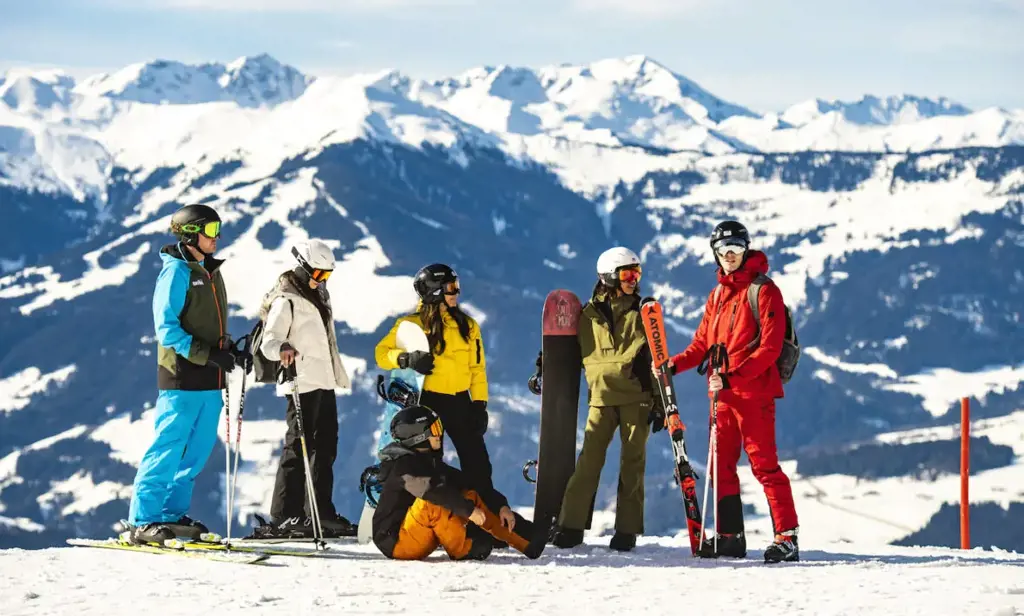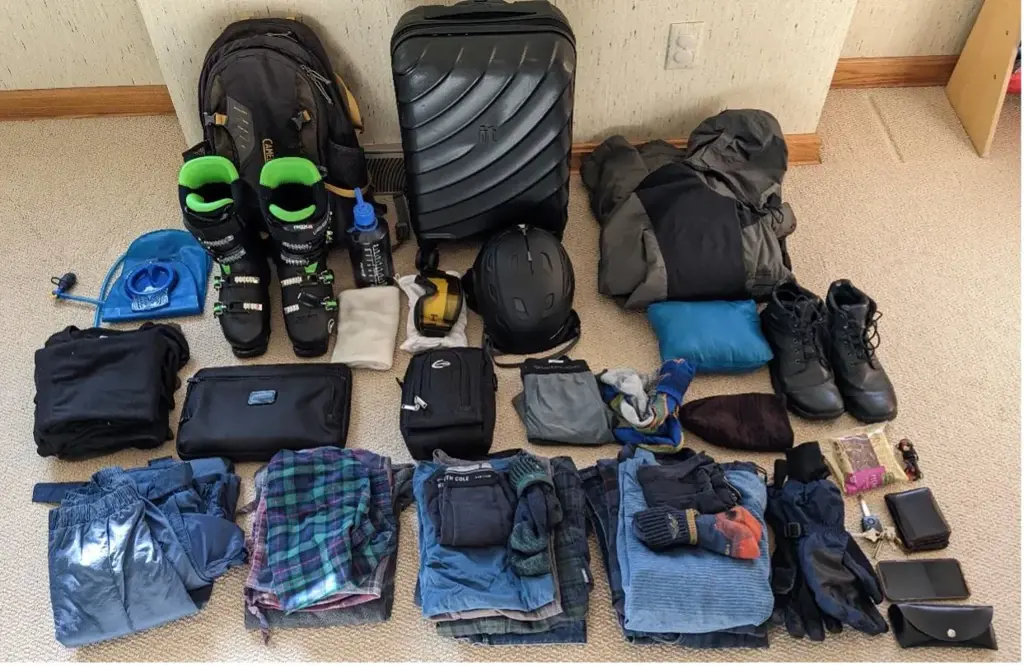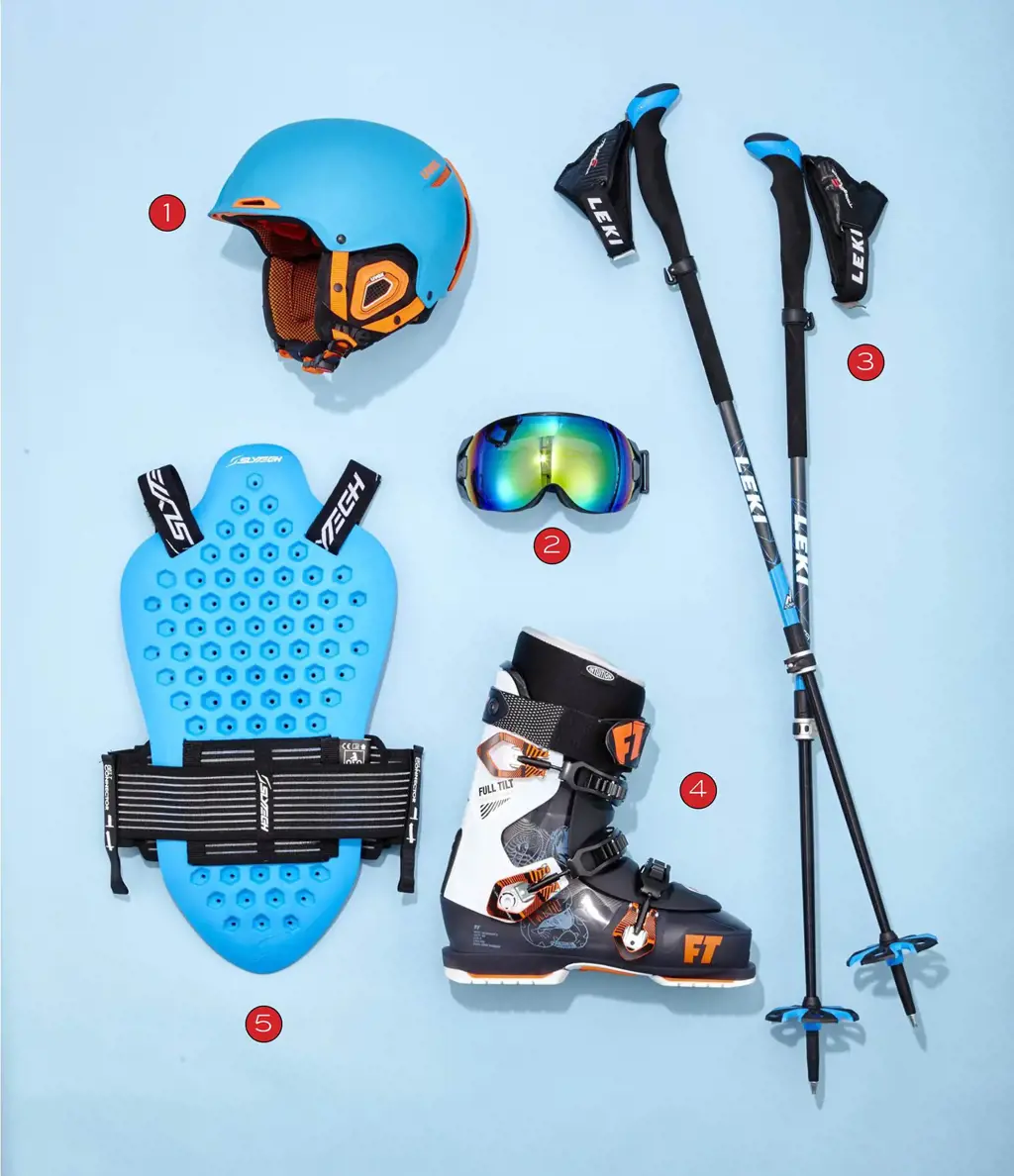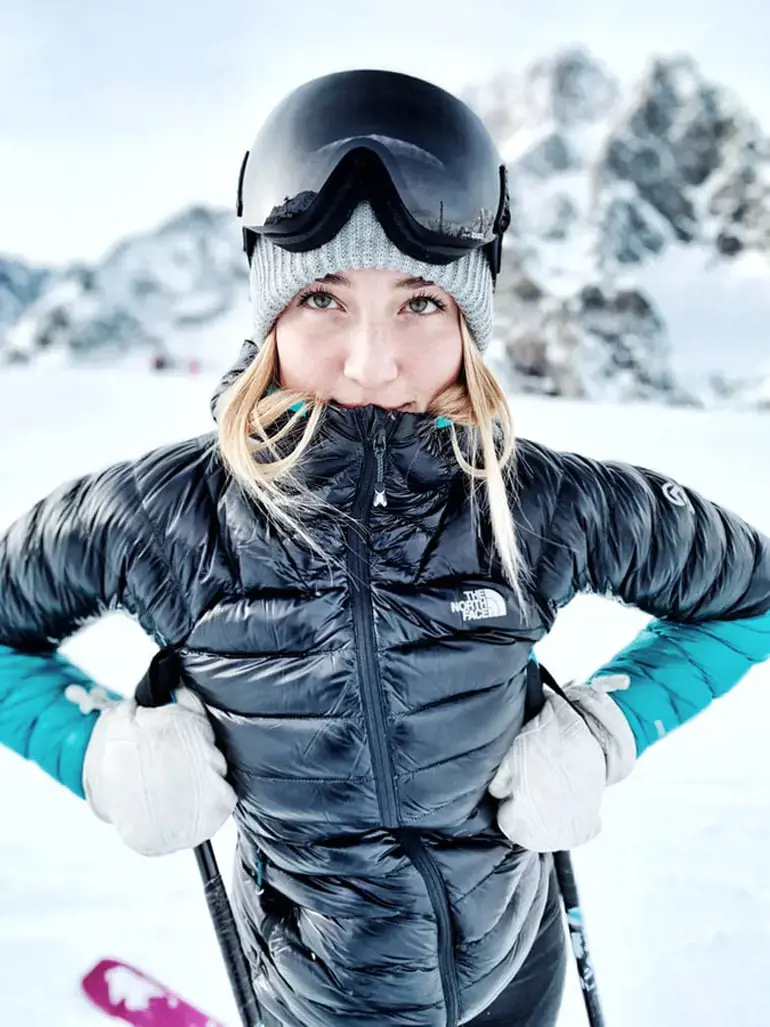
Are you planning a European ski trip and wondering what essentials you need to bring? Look no further! Whether you are a seasoned skier or a first-timer hitting the slopes, packing the right items is crucial for a memorable and comfortable trip. From warm and insulating clothing to must-have ski gear, this guide will ensure you have everything you need to make the most of your European ski adventure. So grab your suitcase, dust off your skis, and get ready to hit the snow-covered mountains of Europe in style!
| Characteristics | Values |
|---|---|
| Destination | European ski resort |
| Weather | Cold and snowy |
| Clothing | Ski jacket, pants, thermal layers |
| Accessories | Gloves, hat, scarf, goggles |
| Footwear | Ski boots, warm socks |
| Equipment | Skis or snowboard, poles |
| Safety gear | Helmet, back protector |
| Clothing for evenings | Warm sweater, jeans, boots |
| Miscellaneous | Sunscreen, lip balm, hand warmers |
| Travel documents | Passport, visa, travel insurance |
What You'll Learn
- What essential clothing items should I pack for a European ski trip?
- Are there any specific accessories or gear that are necessary for a ski trip in Europe?
- How should I pack my ski equipment for a European ski trip?
- Are there any specific safety items or precautions I should pack for a European ski trip?
- What non-clothing items should I pack for a European ski trip, such as toiletries or entertainment options?

What essential clothing items should I pack for a European ski trip?

When preparing for a European ski trip, it is crucial to pack the right clothing items to ensure your comfort and safety on the slopes. Whether you are a beginner or an experienced skier, having the appropriate gear will allow you to fully enjoy your time in the mountains. Here are the essential clothing items you should consider packing for your European ski adventure:
- Base Layers: Start with a good set of base layers, including thermal tops and bottoms. These layers play a crucial role in regulating your body temperature and wicking away sweat. Look for moisture-wicking fabrics such as merino wool or synthetic materials like polyester.
- Mid-Layers: Mid-layers provide insulation and help trap heat. Opt for fleece jackets, thin wool sweaters or synthetic insulated jackets. They should fit comfortably under your outerwear and allow for freedom of movement.
- Outerwear: A waterproof and breathable ski jacket and pants are essential to protect you from the cold, wet weather on the slopes. Look for materials with high waterproof and breathability ratings. Additionally, make sure your outerwear has plenty of pockets for storage and adjustable features to customize the fit.
- Ski Socks: Invest in a few pairs of high-quality ski socks made of merino wool or synthetic blends. These socks provide cushioning and insulation, ensuring that your feet stay warm and dry throughout the day.
- Gloves or Mittens: Opt for gloves or mittens that are waterproof and insulated to protect your hands from the cold and wet conditions. Mittens generally offer better warmth but can limit dexterity, while gloves provide more flexibility.
- Helmet: Safety should always be a top priority when skiing. A well-fitting helmet that meets safety standards is a must to protect your head from potential injuries. Make sure it is comfortable and secure, and consider choosing one with adjustable vents for temperature control.
- Goggles: Proper eye protection is essential when skiing. Look for goggles with polarized lenses to reduce glare and provide clear vision on the slopes. They should also have good ventilation to prevent fogging.
- Neck Gaiter or Balaclava: Protect your face and neck from the cold wind and snow by packing a neck gaiter or balaclava. These accessories can be worn under your helmet and provide an extra layer of warmth.
- Thermal Underwear: In addition to base layers, packing thermal underwear such as long johns can provide extra warmth and insulation, especially on particularly cold days.
- Ski Boots: Properly fitting ski boots are essential for comfort and control on the slopes. Make sure to choose boots that provide good ankle support and a secure fit. Consider getting your boots fitted by a professional to ensure a proper fit and minimal discomfort.
Remember to layer your clothing to adjust to changing weather conditions and always check the weather forecast before heading out. It is better to have too many layers and remove them as needed than to be underprepared. By packing these essential clothing items, you will be well-equipped to enjoy your European ski trip to the fullest.
The Essential Packing List for a 7-Day Cruise
You may want to see also

Are there any specific accessories or gear that are necessary for a ski trip in Europe?

When it comes to planning a ski trip in Europe, there are a few accessories and gear that are necessary to ensure a successful and enjoyable experience on the slopes. Whether you're a seasoned skier or a beginner, having the right equipment can make all the difference in your comfort and safety on the mountain.
First and foremost, a good pair of ski boots is essential. Invest in a pair that fits snugly but not too tight, as you'll be spending a lot of time in them. Look for boots with a sturdy sole and good ankle support to provide stability while skiing. It's also a good idea to get your boots professionally fitted to ensure proper alignment and comfort.
Next, you'll need a set of skis or a snowboard. The type of equipment you choose will depend on your skill level and personal preference. For beginners, it's often recommended to start with skis as they tend to be easier to learn on. However, if you've had experience snowboarding or are interested in trying it out, a snowboard may be the right choice for you.
In addition to skis or a snowboard, you'll also need bindings to secure your boots to the equipment. Make sure the bindings are properly adjusted and aligned with your boots to avoid any strain or injury while skiing. It's a good idea to have a professional check and adjust your bindings before hitting the slopes, especially if you're a beginner or have recently switched equipment.
To protect your head, it's crucial to wear a properly fitted ski helmet. Even if you consider yourself a skilled skier, accidents can happen, and a helmet can significantly reduce the risk of head injuries. Look for a helmet that meets safety standards and has proper ventilation to prevent overheating.
Another important accessory to have is a pair of high-quality ski goggles. Goggles protect your eyes from the wind, sun, and snow while providing clear visibility on the slopes. Look for goggles with a wide field of vision, anti-fog coating, and UV protection. It's also a good idea to bring a spare pair of goggles or extra lenses in case the weather conditions change unexpectedly.
To keep your hands warm and dry, invest in a good pair of ski gloves or mittens. Look for gloves that are waterproof, insulated, and have a secure wrist closure to prevent snow from getting in. It's also important to choose gloves that allow for dexterity so you can easily adjust your equipment and hold onto ski poles if necessary.
Finally, don't forget to dress in layers to keep your body temperature regulated while skiing. Start with a moisture-wicking base layer to keep you dry, followed by a warm and breathable mid-layer, such as a fleece or thermal shirt. On top, wear a waterproof and windproof outer layer, such as a ski jacket and pants, to protect you from the elements. It's also advisable to bring extra layers in case the weather changes throughout the day.
In conclusion, while planning a ski trip in Europe, it's important to make sure you have the right accessories and gear to ensure a safe and enjoyable experience on the slopes. This includes a properly fitted pair of ski boots, skis or a snowboard, bindings, a ski helmet, ski goggles, ski gloves or mittens, and appropriate layers of clothing. By investing in high-quality equipment and taking the time to fit it correctly, you'll be well-prepared to tackle the European ski slopes with confidence.
Essential Items to Pack for Boardmasters: Your Complete Guide
You may want to see also

How should I pack my ski equipment for a European ski trip?

When preparing for a European ski trip, it is important to pack your ski equipment carefully to ensure its safe arrival and to make the most of your ski holiday. Here are some tips on how to pack your ski equipment for a European ski trip:
- Check the airline's baggage policy: Before you start packing, it is important to check the airline's baggage policy regarding ski equipment. Different airlines have different rules, so make sure you are aware of any size, weight, or additional charges for carrying your ski gear.
- Invest in a ski bag: A ski bag is an essential item for transporting your ski equipment. Look for a padded ski bag with sturdy zippers and handles. The padding will protect your skis or snowboard from any damage during transit, while the handles and straps will make it easier to carry.
- Disassemble and secure your skis or snowboard: To fit your skis or snowboard in the ski bag, you will need to disassemble them. Remove the bindings from your skis or snowboard and pack them separately. Secure the edges of your skis or snowboard with edge guards or bubble wrap to prevent any damage.
- Pack your boots, clothing, and accessories: In addition to your skis or snowboard, pack your ski boots, clothing, and accessories in the ski bag. Wrap your boots in plastic bags or put them in a separate boot bag to protect your other gear from dirt and moisture. Pack your ski clothing, such as jackets, pants, gloves, and hats, in plastic bags or compression sacks to save space and keep them clean. Don't forget to pack your goggles, helmets, and other accessories as well.
- Fill empty spaces with soft items: To make the most of the space in your ski bag, fill any gaps or empty spaces with soft items, such as socks, hats, or even your ski jacket. This will provide additional padding and help protect your ski equipment during transit.
- Label your ski bag: Attach a luggage tag or write your name and contact information on your ski bag. This will make it easier to identify your bag at the airport and allow airline staff to contact you in case it gets lost or misplaced.
- Check the weight and dimensions: Before heading to the airport, make sure your ski bag complies with the airline's weight and dimension restrictions. Use a weighing scale to check the weight of your bag and a measuring tape to measure its dimensions. This will help you avoid any additional charges or issues at the airport.
- Insure your ski equipment: Consider getting travel insurance that covers your ski equipment. Accidents and mishaps can happen during transit, and having insurance will provide peace of mind and financial protection in case of loss, theft, or damage to your ski gear.
By following these steps, you can ensure that your ski equipment arrives safely and in good condition for your European ski trip. Proper packing and preparation will help you make the most of your ski holiday and enjoy your time on the slopes.
Essential Items to Pack for Your Bora Bora Vacation
You may want to see also

Are there any specific safety items or precautions I should pack for a European ski trip?

Planning for a ski trip in Europe? It's important to consider safety as a top priority. Skiing and snowboarding can be thrilling, but they also come with inherent risks. To ensure a safe and enjoyable experience, it's crucial to pack the right safety items and take necessary precautions. Here are some essential safety tips for your European ski adventure.
- Protective Gear: When hitting the slopes, it's important to have the right protective gear. This includes a well-fitting helmet, goggles, and gloves. A helmet is crucial to protect your head from potential injuries, while goggles shield your eyes from snow glare and UV rays. Good quality gloves will not only keep your hands warm but also provide protection in case of a fall.
- Layered Clothing: European ski resorts vary greatly in weather conditions, so it's important to pack layers for varying temperatures. Start with a moisture-wicking base layer to keep you dry and warm. Add a mid-layer like a fleece or down jacket for insulation. Finally, a waterproof and insulated outer layer will protect you from wind, snow, and wet conditions. Don't forget to pack extra pairs of socks to keep your feet dry and warm.
- Sun Protection: The sun in higher altitudes can be intense, even on cloudy days. Pack a high SPF sunscreen and apply it generously to exposed areas of skin, including your face, neck, and hands. Additionally, use lip balm with SPF to protect your lips from windburn and sun damage. Don't forget to wear a hat or a helmet with a visor to shield your face from the sun's harmful rays.
- Avalanche Safety Equipment: If you plan to venture off-piste or into backcountry areas, it's crucial to have the necessary avalanche safety equipment. This includes an avalanche transceiver, probe, and shovel. Prioritize safety by attending a local avalanche safety course to learn how to use this equipment and understand the risks associated with skiing in avalanche-prone areas.
- First Aid Kit: Accidents can happen on the slopes, so it's essential to carry a basic first aid kit. Make sure it includes band-aids, sterile gauze, adhesive tape, pain relievers, blister pads, and any necessary personal medications. Having a compact first aid kit on hand could save you from inconveniences and ensure prompt attention to any injuries.
- Know Your Limits: One of the most important safety precautions is to know your limits and ski within your abilities. Don't attempt difficult slopes or terrain beyond your skill level. Respect the mountain and ski responsibly, taking breaks when needed to avoid fatigue and lessen the chances of accidents.
- Stay Hydrated and Nourished: Skiing is physically demanding, and it's easy to get dehydrated or fatigued. Drink plenty of water throughout the day to stay hydrated, and carry a water bottle with you. Pack energy-rich snacks like granola bars or trail mix to keep your energy levels up throughout the day.
Remember, safety should be your top priority during a ski trip in Europe or anywhere else. By packing the necessary safety items and taking proper precautions, you can lower the risks and ensure a memorable and incident-free experience on the slopes. So, gear up, stay safe, and enjoy your European ski adventure to the fullest!
Essential Items to Pack for a Trip to Lapland
You may want to see also

What non-clothing items should I pack for a European ski trip, such as toiletries or entertainment options?

When packing for a European ski trip, it's important to consider not only the necessary clothing items but also other essentials and entertainment options to make your trip comfortable and enjoyable. In addition to the usual toiletries and entertainment items, there are a few specific things to keep in mind when packing for a ski trip. Here are some non-clothing items that you should consider packing for your European ski adventure:
Toiletries:
- Sunscreen: Even though it may be cold, the sun's rays can still be strong on the slopes. Make sure to pack sunscreen with a high SPF to protect your skin from harmful UV rays.
- Lip balm with SPF: The cold and wind can be harsh on your lips, so it's a good idea to pack a lip balm with SPF to keep them moisturized and protected.
- Hand and body moisturizer: The cold weather and frequent handwashing can dry out your skin, so packing a good hand and body moisturizer is essential to keep your skin hydrated.
- Travel-size toiletries: Opt for travel-size toiletries to save space in your luggage. Many stores sell travel-size versions of shampoo, conditioner, and shower gel, making it easier to pack efficiently.
Electronics and Entertainment:
- Portable charger: When you're out on the slopes all day, you may not have easy access to a power outlet. A portable charger can come in handy to keep your electronic devices powered up throughout the day.
- E-books or audiobooks: If you enjoy reading or listening to books, consider packing an e-reader or downloading some audiobooks onto your phone or tablet. This way, you can relax and unwind after a long day on the slopes.
- Portable Bluetooth speaker: If you enjoy listening to music, having a portable Bluetooth speaker can enhance your ski trip experience. You can play your favorite tunes while getting ready in the morning or relaxing in your accommodation after a day of skiing.
- Camera or GoPro: Capture the beautiful scenery and your skiing adventures with a camera or a GoPro. These devices can help you create lasting memories of your ski trip and share them with friends and family.
First Aid Kit and Medications:
- Basic first aid supplies: Pack a small first aid kit with essentials like band-aids, antiseptic wipes, and pain relievers. Minor injuries can happen on the slopes, and it's always better to be prepared.
- Prescription medications: If you take any prescription medications, make sure to pack enough for the duration of your trip. It's also a good idea to carry a copy of your prescription in case you need to get a refill abroad.
Remember that some items, such as toiletries, can be purchased at local stores once you arrive at your destination. However, it's always a good idea to pack the essentials to ensure you have everything you need, especially if you have specific preferences or requirements.
In conclusion, besides packing the necessary clothing items for a European ski trip, it's important to consider other non-clothing essentials and entertainment options. By packing toiletries such as sunscreen, lip balm, and moisturizer, you can protect your skin from the cold and sunburn. Bringing along electronics and entertainment options like portable chargers, e-books or audiobooks, portable speakers, and cameras or GoPros, you can keep yourself entertained during downtime. Additionally, don't forget to include a first aid kit with basic supplies and any necessary prescription medications to ensure your safety and health throughout your trip. With these additional items packed, you'll be well-prepared for your European ski adventure.
Essential Items to Pack for a Business Trip to Oslo
You may want to see also
Frequently asked questions
When packing for a European ski trip, it is important to bring layers of clothing to accommodate changing weather conditions. This includes a waterproof and insulated ski jacket, ski pants, thermal or base layers, mid-layers such as fleece or down jackets, and ski socks. Don't forget to include gloves, a hat, and a neck gaiter to protect yourself from the cold.
Whether to bring your own ski equipment or rent it depends on various factors such as cost, convenience, and personal preference. If you are a frequent skier or have specific requirements, bringing your own equipment may be beneficial. However, if you are a beginner or an occasional skier, renting equipment can be more cost-effective and eliminate the need to transport bulky items.
In addition to clothing and ski equipment, there are a few additional accessories that you should consider packing for a European ski trip. These include sunscreen and lip balm with a high SPF, goggles or sunglasses to protect your eyes from the sun and snow glare, a small backpack or fanny pack for carrying essentials on the slopes, and hand warmers or foot warmers to keep you comfortable in freezing temperatures.
It is highly recommended to have travel insurance when going on a European ski trip. This type of insurance can provide coverage for medical expenses, trip cancellations or interruptions, lost or stolen baggage, and other unforeseen circumstances. Skiing carries inherent risks, and having travel insurance can give you peace of mind and protect you financially in case of any accidents or emergencies.







